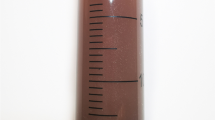Abstract
Nipple blebs are blister-like fibrinous lesions that form on the surface of the nipple during lactation, and can result in orifice obstruction and mastitis. They likely result from superficial extension of underlying ductal plugging, and can present concurrently with hyperlactation and mammary dysbiosis. Despite their prevalence, few formal reports on nipple blebs exist. In this perspective, we review the experience of a breastfeeding medicine practice that receives referrals for patients with nipple blebs, and provide preliminary insight into etiology, management, and outcomes of these lesions.



Similar content being viewed by others
References
Tait P. Nipple pain in breastfeeding women: causes, treatment, and prevention strategies. Journal of midwifery women’s health. 2000;45(3):212–5.
Mitchell KB, Johnson HM, Eglash A. ABM Clinical Protocol #30: Breast Masses, Breast Complaints, and Diagnostic Breast Imaging in the Lactating Woman. Breastfeed Med. 2019;14(4):208–14.
Amir LH. Academy of Breastfeeding Medicine Protocol Committee. ABM clinical protocol #4: Mastitis, revised March 2014. Breastfeed Med. 2014;9(5):239–43.
Little S. Re. Managing common breastfeeding problems in the community. BMJ. https://www.bmj.com/content/348/bmj.g2954/rr/698430. Published 2014. Accessed 3 Oct 2019.
O’Hara M. Bleb histology reveals inflammatory infiltrate that regresses with topical steroids: a case series. Abstracts: The Academy of Breastfeeding Medicine 17th Annual International Meeting. Breastfeed Med. 2012;7:–2.
Johnson HM, Eglash A, Mitchell KB, et al. ABM Clinical Protocol #32: Management of Hyperlactation. Breastfeed Med. 2020;15(3):129–34.
Lavigne V, Gleberzon BJ. Ultrasound as a treatment of mammary blocked duct among 25 postpartum lactating women: a retrospective case series. J Chiropr Med. 2012;11(3):170–8.
Mitchell KB, Eglash A, Bamberger ET. Mammary dysbiosis and nipple blebs treated with intravenous daptomycin and dalbavancin. J Hum Lact. 2019:890334419862214.
Heller MM, Fullerton-Stone H, Murase JE. Caring for new mothers: diagnosis, management and treatment of nipple dermatitis in breastfeeding mothers. Int J Dermatol. 2012;51(10):1149–61.
Campbell SH. Recurrent plugged ducts. J Hum Lact. 2006;22(3):340–3.
Gidrewicz DA, Fenton TR. A systematic review and meta-analysis of the nutrient content of preterm and term breast milk. BMC Pediatr. 2014;14:216.
Adams EG, Kemp JD, Holcomb KZ, Sperling LC. Xanthogranulomatous reaction to a ruptured galactocele. J Cutan Pathol. 2010;37(9):973–6.
Jimenez E, Arroyo R, Cardenas N, et al. Mammary candidiasis: A medical condition without scientific evidence? PLoS One. 2017;12(7):e0181071.
Gomez-Gallego C, Garcia-Mantrana I, Salminen S, Collado MC. The human milk microbiome and factors influencing its composition and activity. Semin Fetal Neonatal Med. 2016;21(6):400–5.
Moossavi S, Sepehri S, Robertson B, et al. Composition and Variation of the Human Milk Microbiota Are Influenced by Maternal and Early-Life Factors. Cell Host Microbe. 2019;25(2):324–35.e324.
WHO. World Health Organization. Disease outbreak news. Carbapenem-resistant Pseudomonas aeruginosa infection – Mexico. 5 March 2019. https://www.who.int/csr/don/5-march-2019-carbapenem-resistant-p-aeruginosa-mex/en/. Accessed 8 Oct 2019.
WHO. Mastitis: causes and management. Publication Number WHO/FCH/CAH/00.13. Geneva: World Health Organization; 2000.
Author information
Authors and Affiliations
Corresponding author
Additional information
Publisher's Note
Springer Nature remains neutral with regard to jurisdictional claims in published maps and institutional affiliations.
Rights and permissions
About this article
Cite this article
Mitchell, K.B., Johnson, H.M. Breast Pathology That Contributes to Dysfunction of Human Lactation: a Spotlight on Nipple Blebs. J Mammary Gland Biol Neoplasia 25, 79–83 (2020). https://doi.org/10.1007/s10911-020-09450-7
Received:
Accepted:
Published:
Issue Date:
DOI: https://doi.org/10.1007/s10911-020-09450-7




